Director’s Desk
July and early August were extremely busy months for travelling to conservation drainage focused field days and workshops around the Midwest. Although busy, it was beneficial to see the various stages states are at with programs for conservation drainage practices. Iowa and Minnesota seemingly have the most experience with utilizing federal or state cost share programs, while Illinois has strong research and demonstration sites that have been installed through partner efforts and to a lesser extent public funding. South Dakota is somewhat the new kid on the block when it comes to drainage. As ADMC member Scott Hansen of East River Land Improvement put it, South Dakota needs take advantage of the lessons learned from Iowa, Illinois, and Minnesota’s 100 plus years of drainage experience. Â
The Advanced Conservation Draining Training series wrapped up after a late July constructed wetland session and a drainage water management session on August 7th. The constructed wetland construction was at Illinois Central College’s Nutrient Loss Reduction Farm which also has a bioreactor. Illinois LICA was on hand all week to excavate the constructed wetland. ADMC members who were participating associates for the wetland were Agri Drain Corporation, Fratco Inc., and Schlatter’s Inc.
The drainage water management classroom session and field day was held in conjunction with the University of Illinois Extension Summer Drainage Workshop at Richland Community College in Decatur, IL. Springfield Plastics, Advanced Drainage Systems, and IL LICA were ADMC members who participated in the event. Following the classroom session, there was a field day hosted by Al Boyd. Boyd utilizes DWM on a new drainage system which drains to a constructed pond. There is a pump system set up to be able to sub-irrigate from the pond in the late summer months. This year was an ideal year to take advantage of this sort of system.
I was able to present on the scalability and impact of saturated buffers at the annual Soil and Water Conservation Society International meeting in Pittsburgh, PA. It was a well-attended presentation as SWCS informed me that it was the 2nd most attended breakout oral presentation of the meeting. The theme of the conference was “Bridging the Divide: Uniting Rural and Urban Landscapes for Conservation”.

Keegan Kult ADMC Executive Director
Â
ADMC Diamond Members
ADMC Member Spotlight
Collaboration Results in Successful Bioreactor Installation to Study Water Quality Conservation
The Northwest Research and Demonstration Farm in Iowa is a great example of conservation-minded farmers proactively investing in water quality innovation in collaboration with land grant universities and industry professionals. The NW Research and Demonstration Farm near Sutherland, Iowa is owned by a non-profit association of local farmers and home to a wide variety of water management research projects led by staff and students from Iowa State University.
In February of 2019, Terry Tuttle, Farm Superintendent, approached Matt Helmers, Director of the ISU Nutrient Research Center, about studying water quality conservation with the installation of a bioreactor. The use of bioreactors is slowly gaining traction because of their potential to reduce nitrate in drainage outputs by up to 50%.
Matt was on board with the idea and designed a 30-acre drainage system, following NRCS standards, that would filter through a wood chip bioreactor. He estimated the sizes and volume of pipe needed, then worked with Ken Skinner, Agricultural Salesman from Prinsco, to get everything ordered. Brian Heinsohn from Heinsohn Digging and Tiling helped to refine the system design, get the product on-site and provide all of the installation services.
This new bioreactor is 20’ wide x 100’ long x 4’ deep and filled with carbon-rich wood chips that serve as a substrate for bacteria that breaks down nitrate. Monitoring devices will be installed soon to begin collecting flow rate data and water samples for nitrate testing. Part of the project is to determine the maximum life of the bioreactor, which is currently expected to be between 10-20 years.
A recent Open House for the project was a success and it’s expected that hundreds of industry experts, students and members of the public will visit and learn from this project over the next several years. Jamie Duininck, Co-owner of Prinsco adds,†We are proud to be involved in these types of initiatives and have had a strong history of investing in research and innovation around water quality conservation practices.â€
Thanks to everyone involved for keeping water quality innovation moving forward.
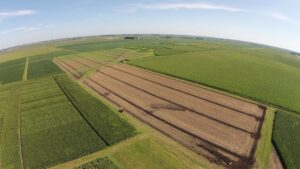
A 30-acre drainage system using Prinsco pipe was designed and installed to feed the bioreactor. Photo Credit: ISU Northwest Research and Demonstration Farm.
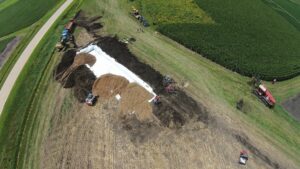
The wood chip bioreactor is 20’ wide x 100’ long x 4’ deep. Photo Credit: ISU Northwest Research and Demonstration Farm.

Carbon-rich wood chips will break down nitrates in the water before it reaches the system outlet. Photo credit: Matthew Helmers, ISU Director of the Nutrient Research Center
Â
CTIC Conservation in Action Tour at the Couser Modern Farm Experience
The most recent field day was at the Couser Farm in central Iowa for the annual CTIC Conservation Tour. I was able to talk about bioreactors and saturated buffers to the approximate 150 tour attendees. Attendees included agency, industry, media, and NGO personnel. The Couser farm is set up as the Modern Farm Experience and is host to numerous tours throughout the year.Â
As usual it was great to see the use of ADMC members services to construct the bioreactor. Ecosystem Services Exchange designed the site, Agri Drain control structures were used, Prinsco pipe plumbed the bioreactor, and J. Pettiecord wood chips are fueling the bioreactor.
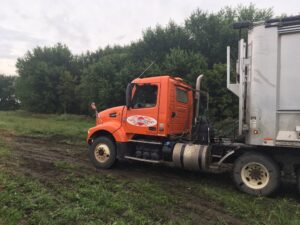
J. Pettiecord delivering wood chips to the site.
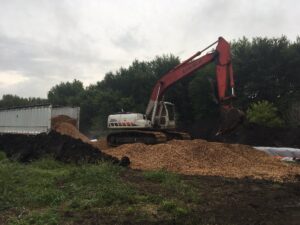
Wood chips being spread in the chamber.

Agri Drain smart drainage system designed by ESE.
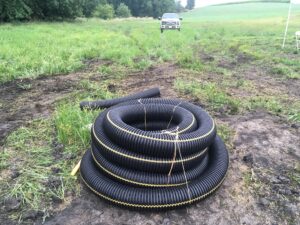
Prinsco pipe used to plumb the bioreactor.
The Cousers had two 80-acre fields on the demonstration farm that they were not happy with the performance during wet years. Realizing that they had limited the potential of the fields without a pattern system, they decided to invest in smart drainage. The North 80 is a flatter field, so automated controlled drainage will be utilized. The South 80 has more relief to it and is also being set up in drainage quadrants to evaluate in-field practices, so it will have two bioreactors and two saturated buffers on the outlets. Â For more information on the practices utilized on the farm, check out the ADMC Couser Modern Farm Experience fact sheet.
Not only is the Couser farm demonstrating the latest conservation practices, it is demonstrating how to go through current financial assistance models which is an important lesson on taking the next step to scale up practices. Due to the high profile of the farm there is plenty of industry support that probably could have been leaned on to pay for the conservation drainage practices, but the planning team which included Bayer, EPA, AgriDrain, Ecosystem Services Exchange, Iowa State University, Hands On Excavating, and NRCS, knew it would be beneficial to demonstrate how to use current financing mechanisms. Funding was available through the USDA-NRCS EQIP program and through the Iowa Department of Agriculture and Land Stewardship (IDALS) Water Quality Initiative.
Taking full advantage of current financial assistance models is the next logical step in the attempt to scale up conservation drainage implementation. Conservation finance and nitrate trading markets are going to rely on the most cost-efficient practice delivery system. Current conservation drainage practices have been installed in more of an ad-hoc manner with at most a couple of practices installed in a project area. Ad-hoc installations does not lend itself to being cost efficient, especially in terms of siting and design costs. Limited sites to construct also means that saturated buffers and bioreactors are not priorities for drainage contractors.
It is time to start pushing the system that we have in place now to install conservation drainage practices like bioreactors and saturated buffers in quantities closer to 25-50 in a project year rather than 1 or 2. Iowa is a good testing ground for this as there is state funding available to match with federal funding to ease the financial burden to the landowner. IDALS also has an edge of field project coordinator in place to guide the practices through the design and installation phase.
For more information on the CTIC tour, check out the Progressive Farmer article on the day here.
Conservation Drainage Events
Share on twitter
Twitter





